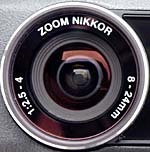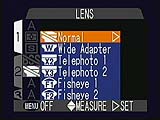Digital Camera Home > Digital Camera Reviews > Nikon Digital Cameras > Nikon CoolPix 990
Nikon CoolPix 990
Nikon updates the hugely successful Coolpix 950, with 3.34 megapixels and numerous enhancements
<<Viewfinder :(Previous) | (Next): Exposure & Flash>>
Page 5:Optics
Review First Posted: 3/1/2000
|
 Optics
Optics
A Nikkor 3x zoom, 8 to 24mm lens comes with the camera (the equivalent of a 38 to 115 mm lens on a 35mm camera), with nine elements in eight groups (all made up of environmentally friendly glass). Aperture ranges from F/3.5 to F/9.8. New to the 990 model is the seven blade iris diaphragm, which gives very fine-grained aperture control, useful for controlling depth of field, but more so for working with external flash and precisely controlling the balance between flash and ambient exposure. The contrast-detect TTL autofocus features a 4,896 step autofocus mechanism with a working range from 0.8 inches (2.0 cm) to infinity (this includes the macro range). When shooting in the Auto exposure mode, the autofocus remains in the Continuous setting while using the LCD monitor but reverts to the Single autofocus mode when the LCD is off (which means you must halfway press the shutter button to set focus). However, the Manual capture mode gives you the freedom to choose between Continuous or Single autofocus, regardless of LCD status.

The Continuous focus mode results in the lens continually "hunting" for the best focus as you move the camera around, settling down when the camera and/or subject stops moving. Autofocus tracking speed isn't terribly high (mentioned in case you were expecting AF tracking as on Nikon's F5 pro film camera), but the continuous option would definitely be a benefit with moving subjects. The downside is that it burns more battery power.

The manual focus option is controlled through the settings menu and offers choices between a peaking scale or a distance readout (extremely beneficial in hard to focus situations). Once enabled, just press the Manual Focus button (lower left of the LCD monitor) and simultaneously turn the command dial to adjust the focus in 50 steps.

As a focus aid in manual focus mode (it can also be enabled in autofocus modes as well), the Coolpix 990 has a clever "peaking" display. This appears to be some sort of on-screen sharpening function that tends to exaggerate the current state of focus of the camera: In-focus objects look extra-sharp on the LCD when "peaking" is enabled. With textured objects, the peaking display mode produces a glimmering, moire-type effect on the display screen. We didn't test manual-focus accuracy extensively, so can't comment on just how well this works, but it is clearly a step ahead of most digicams, in which the LCD screen has far too little resolution to be of practical use in evaluating focus.

We should note here that the 990's autofocus mechanism is quite sophisticated, with several operating modes. It has five possible focus zones (center, top, bottom, left, right), which can be very useful for achieving accurate focus on off-center subjects. The screenshots above right show the camera preferentially focusing on two objects at very different distances, based on the focus area selected. It could also take some getting used to if you're accustomed to lesser cameras with only a single focus zone. The Focus option under the settings menu does allow you to choose modes in which the camera chooses the focus zone, or in which you can explicitly set the location of the focus area (a nice feature that works well when combined with the spot metering mode, which can likewise be directed to determine exposure from the same 5 zones). In the "Auto" option for focus-area selection, the camera chooses the area corresponding to the object closest to the camera. When the area focus option is set to Off, the camera bases focus on the central area. (One playback mode displays a focus-area overlay, and shows which focus area was chosen for each image, by highlighting the appropriate set of marks in green. - This last function wasn't yet operational on our test unit.) Overall, the 990's focusing system is by far the most sophisticated we've seen on any digicam to date


The lens itself has the same filter threads as the preceding Coolpix models, which accommodate Nikkor accessory lenses for wide-angle, telephoto, macro and fisheye focal lengths. Once a lens is attached, you'll need to select the corresponding lens type in the lens settings menu, shown at right. (The camera adjusts its operation for different lens types by restricting the zoom range to avoid vignetting, switching to center-weighted metering for the fisheye adapter, etc.) A digital telephoto feature can be turned off and on through the Zoom option under the Settings menu, enlarging images up to 4x. The 990's digital zoom is different from most in that it provides a smoothly-varying range of magnifications. An indicator on the LCD monitor displays the range of digital zoom at each step (from 1.1x to 4.0x). Like this feature on most digicams, digital telephoto on the Coolpix 990 enlarges the center of the image, resulting in reduced resolution and more artifacts as more digital zoom is used. The camera automatically switches to center-weighted metering and a center autofocus target when digital zoom is active. Also under the Zoom option, you can set the startup position of the lens (either wide or telephoto) and activate the Fixed Aperture function, which keeps the aperture fixed as the lens zooms. The startup position option was another highly-requested feature among '950 users, and can really save precious seconds in fast shooting situations. Likewise, the fixed-aperture zoom option is very useful when working with external flash units, to avoid varying the exposure as a function of lens focal length.


Follow Imaging Resource: